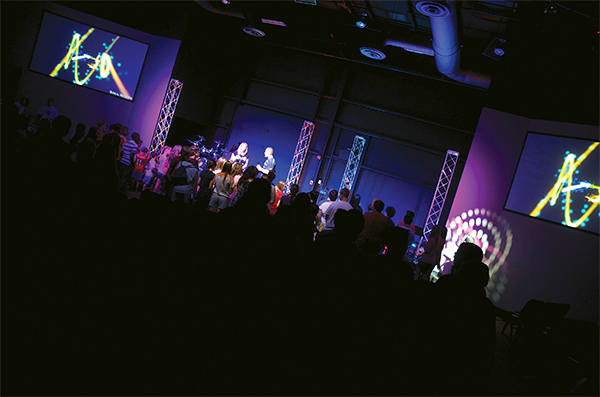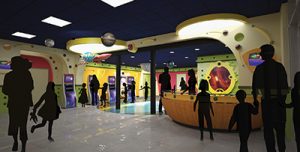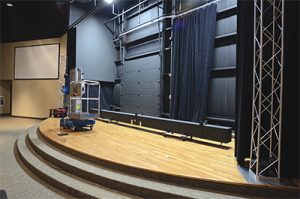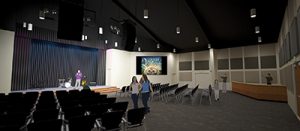
By Curtiss H. Doss, AIA
 Here, in part 4 of this series, we’ll shift toward a worship space designed for a specific age group: preschool / children and students. But before we begin, let me reiterate a primary precept: Every church is different.
Here, in part 4 of this series, we’ll shift toward a worship space designed for a specific age group: preschool / children and students. But before we begin, let me reiterate a primary precept: Every church is different.
If you’re a regular reader of this series, it’s a familiar statement. Why? Because it’s true — and because student ministries are no different.
Many student worship spaces use design elements that promote ministry and embody many of the same elements we find in all worship spaces. However, student worship spaces typically take it to a different level. While the ultimate goal is to worship Jesus, there’s also a practical goal: to maintain a connection with the student, who’s bombarded with all the trappings of today’s culture and crowd. To be successful on both fronts, the architecture and the design of the space must uniquely “speak” to the student population.
 So, what does a student worship space include?
So, what does a student worship space include?
#1: A little space, please. The first, most obvious element lies  outside the room itself: When possible, student spaces are wholly detached (or at least somewhat separated) from the larger church element. This doesn’t prohibit their use by other ministries, but it does provide a “home” for students.
outside the room itself: When possible, student spaces are wholly detached (or at least somewhat separated) from the larger church element. This doesn’t prohibit their use by other ministries, but it does provide a “home” for students.
Today, many youth attending church come from non-traditional households — possibly, dysfunctional ones. The student ministry center, including the worship space, can be a great place for them to call “home.” It’s where all student activities occur and tends to provide a settling effect on the student, thereby opening up opportunities for ministry.
The sensitivity of those who tirelessly minister to the church’s student population is critical. It can play a huge role in each student’s ability to be captured by the power of Jesus. This place — the student worship space, or student ministry center — can make the biggest difference in a student’s life and future.
As such, these spaces must speak to the student. They must encourage participation, be a non-threatening environment, and offer a relaxed atmosphere. Here, students should find gathering spaces, sports spaces, cafés, hangout areas, gaming spaces and so on.
 Again — as with every church — each student ministry center is different. What proves successful in one church might not be part of another student ministry’s DNA. Be very aware of your church’s DNA, and fashion the student spaces around it.
Again — as with every church — each student ministry center is different. What proves successful in one church might not be part of another student ministry’s DNA. Be very aware of your church’s DNA, and fashion the student spaces around it.
#2: Vibrant colors, high-tech elements and theming. Even in traditional churches, student centers tend to be unique and different from most other spaces on the campus. Many create a specific environment, such as a lodge or a coffee shop feel. Let’s face it: Most of us reading this article might feel a bit uncomfortable with this approach. But, we need to remember that it isn’t always about us — and this is certainly the case as it pertains to student ministry areas.
#3: Built-in flexibility. Since student ministries are always changing and programs are varied, its worship space needs to be able to quickly change. Our firm has found that simple construction elements are a must — including a flat floor, highly functional technical systems, and versatile platforms.
 The platform should be concrete if possible; additionally, it’s a good idea to provide vehicle access to the platform via an overhead door. There are numerous times when student ministries want to have cars, motorcycles or other large elements on the platform, not to mention the need to load in and load out musical groups.
The platform should be concrete if possible; additionally, it’s a good idea to provide vehicle access to the platform via an overhead door. There are numerous times when student ministries want to have cars, motorcycles or other large elements on the platform, not to mention the need to load in and load out musical groups.
Additionally, the platform area is a sensitive space due to most building codes. The general desire is to have it function like a stage, with drapes and space above the platform to hang various items.
Many times, the design team walks a fine line with the code officials. Sometimes there are limits to how far to push the envelope.
A real (but fun!) design challenge
All in all, effective student worship space design requires great listening skills. Many student ministries know what they want, but struggle to articulate those needs.
When a student ministry focuses youth toward Jesus and creates a connection between a student and the church in a trouble world, the effort is well worth it.
Curtiss H. Doss, AIA is principal of McGehee Nicholson Burke (MNB) Architects in Memphis, TN. Doss has consulted with church clients for more than 20 years, and his architectural practice spans more than 30 years.



This article is incredible helpful, I was wondering if you had any tips, I am currently trying to renovate an old gymnasium that our church owns, it was built in the 50’s it is 62×44 with 18′ ceilings (exposed junior trusses) with a 30×32 foot room connected. We are looking towards using the gym as half worship and half game/cafe area. At the same time we are on a shoestring budget and I was wondering what would be the specific design elements that you would address. (we having to cover the old asbestos tile floors, and paint the walls, no clue what color to use) any advice that you could give me would be great.